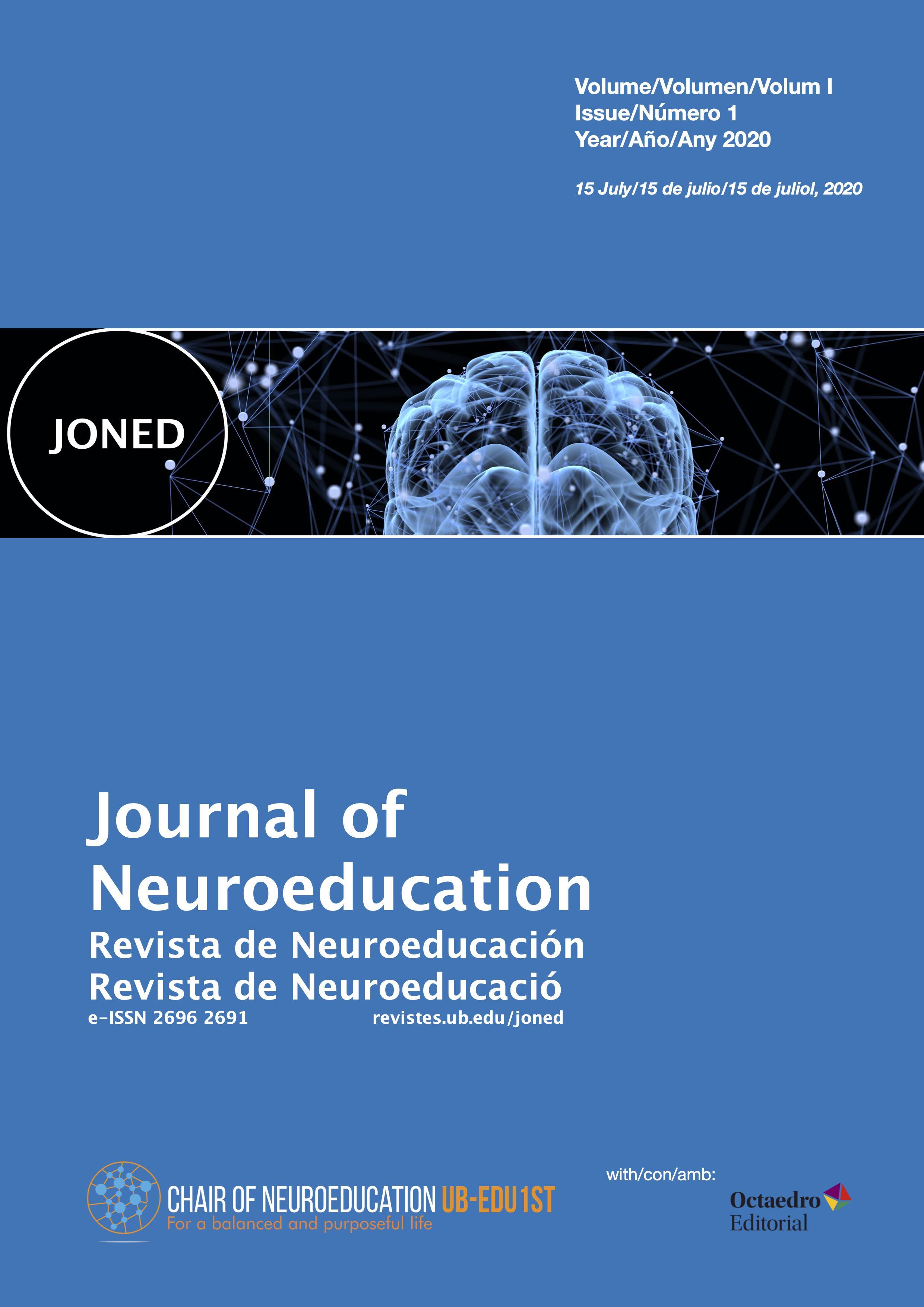Neuroeducation: Teaching with the brain
DOI:
https://doi.org/10.1344/joned.v1i1.31657Keywords:
Social learning, Cognition, Neuroeducation, Education, Learning, Science of learning, Brain functionAbstract
Schooling is an essential and distinctive feature of human beings. Advances in neuroimaging have helped to understand the peculiarities of the human brain and how they relate to our interest on sharing knowledge. The human brain is an organ that evolved to enable the cognitive skills that allow social learning. In turn, education and experience have a major impact on the development of the human brain. The emerging field of Neuroeducation aims at including information about the brain processes related to cognitive skills involved in learning to the efforts of the education community to optimize the transmission and assimilation of knowledge.
Downloads
References
1. Allen JS. The lives of the brain. Human Evolution and the organ of mind. Cambridge, MA: Harvard University Press; 2009.
2. Herrmann E, Call J, Hernández-Lloreda, MV, Hare B, Tomasello, M. Humans have evolved specialized skills of social cognition: the cultural intelligence hypothesis. Science. 2007; 317(5843); 1360-1366. doi: 10.1126/science.1146282
3. Gaur A. A history of writing. London: British Library; 1987.
4. Gottlieb G. From gene to organism: The developing individual as an emergent, interactional, hierarchical system. In: Johnson MJ, Munakata Y, Gilmore R (Eds.) Brain Development and Cognition. A Reader. 2nd Ed. Oxford, UK: Blackwell Publishing; 2002.
5. Huttenlocher PR, Dabholkar AS. Regional differences in synaptogenesis in human cerebral cortex. J Comp Neurol. 1997; 387(2); 167-178. doi: 10.1002/(sici)1096-9861(19971020)387:2<167::aid-cne1>3.0.co;2-z
6. Bogin B. The Evolution of Human Childhood: A unique growth phase and delayed maturity allow for extensive learning and complex culture. BioSci. 1990; 40(1); 16-25. doi: 10.2307/1311235 %J BioScience
7. Clancy B, Darlington RB, Finlay BL. The course of human events: predicting the timing of primate neural development. Dev Sci. 2000; 3(1); 57-66. doi:10.1111/1467-7687.00100
8. Shaw P, Greenstein D, Lerch J, Clasen L, Lenroot R, Gogtay N, et al. Intellectual ability and cortical development in children and adolescents. Nature. 2006; 440 (7084); 676-679. doi:10.1038/nature04513
9. Ericsson KA, Chase WG. Exceptional memory. Am Sci. 1982; 70; 607-615.
10. Crottaz-Herbette S, Menon V. Where and When the Anterior Cingulate Cortex Modulates Attentional Response: Combined fMRI and ERP Evidence. J Cogn Neurosci. 2006; 18(5); 766-780. doi: 10.1162/jocn.2006.18.5.766
11. Petersen SE and Posner MI. The Attention System of the Human Brain: 20 Years After. Annu Rev Neurosci. 2012; 35(1); 73-89. doi: 10.1146/annurev-neuro-062111-150525
12. Rueda MR, Posner MI and Rothbart MK. Attentional control and self-regulation. In Vohs KD and Baumeister RF (Eds.), Handbook of Self-Regulation: Research, theory and applications. 2nd
Edition (pp. 284-299). New York: The Guilford Press; 2011.
13. Rueda MR, Rothbart MK, McCandliss BD, Saccomanno L, Posner MI. Training, maturation, and genetic influences on the development of executive attention. Proc Natl Acad Sci USA. 2005; 102(41); 14931-14936.
14. Stevens C, Fanning J, Coch D, Sanders L, Neville H. Neural mechanisms of selective auditory attention are enhanced by computerized training: Electrophysiological evidence from language-impaired and typically developing children. Brain Research. 2008; 1205; 55-69. doi: 10.1016/j.brainres.2007.10.108
15. Jaeggi SM, Buschkuehl M, Jonides J, Perring WJ. Improving fluid intelligence with training on working memory. Proc Natl Acad Sci USA. 2008; 105(19); 6829-6833.
16. Anguera JA, Boccanfuso J, Rintoul JL, Al-Hashimi O, Faraji F, Janowich J, et al. Video game training enhances cognitive control in older adults. Nature. 2013; 501(7465); 97-101. doi: 10.1038/nature12486
17. Pozuelos JP, Combita LM, Abundis A, Paz-Alonso PM, Conejero Á, Guerra S, Rueda MR. Metacognitive scaffolding boosts cognitive and neural benefits following executive attention training in children. Dev Sci. 2019; 22(2); e12756. doi: 10.1111/desc.12756
18. Rueda MR. Attention in the heart of intelligence. Trends Neurosci Educ. 2018; 13; 26-33. doi: 10.1016/j.tine.2018.11.003
19. Hackman DA, Farah, MJ. Socioeconomic status and the developing brain. Trends Cogn Sci. 2009; 13(2); 65-73. doi: 10.1016/j.tics.2008.11.003
20. Noble KG, Houston SM, Brito NH, Bartsch H, Kan E, Kuperman, JM et al. Family income, parental education and brain structure in children and adolescents. Nat Neurosci. 2015; 18(5); 773-778. doi: 10.1038/nn.3983
21. Bernier A, SD Calkins SD, Bell MA. Longitudinal Associations Between the Quality of Mother-Infant Interactions and Brain Development Across Infancy. Child Dev. 2016;87(4); 1159-74. doi: 10.1111/cdev.12518.
22. Feldman R. The adaptive human parental brain: implications for children’s social development. Trends in Neurosciences. 2015; 38 (6); 387-399. doi: 10.1016/j.tins.2015.04.004
23. Roediger HLIII and Karpicke JD. Test-enhanced learning. Taking memory tests improves long-term retention. Psych Sci. 2006; 17(13); 249-255.
24. Nelson SM, Arnold KM, Gilmore AW, McDermott KB. Neural signatures of test-potentiated learning in parietal cortex. Journal of Neuroscience. 2013; 33(29); 11754-11762.
25. Hammond SI, Müller U, Carpendale JI, Bibok MB, Liebermann-
Finestone DP. The effects of parental scaffolding on preschoolers’ executive function. Developmental Psychology. 2012; 48(1); 271-281. doi: 10.1037/a0025519
26. Diamond A, Barnett WS, Thomas J, Munro S. Preschool Program Improves Cognitive Control. Science. 2007; 318(5855); 1387-1388. doi:10.1126/science.1151148
27. Castellanos FX, Lee PP, Sharp W, et al. Developmental Trajectories of Brain Volume Abnormalities in Children and Adolescents With Attention-Deficit/Hyperactivity Disorder. JAMA.2002; 288(14); 1740–1748. doi: 10.1001/jama.288.14.1740
28. Castellanos FX, Tannock R. Neuroscience of attention-deficit/hyperactivity disorder: the search for endophenotypes. Nature Reviews Neuroscience. 2002; 3(8); 617-628. doi:10.1038/nrn896
29. Courchesne E, Pramparo T, Gazestani VH, et al. The ASD Living Biology: from cell proliferation to clinical phenotype. Molecular Psychiatry. 2019; 24; 88-107. doi: 10.1038/s41380-018-0056-y
30. Peterson RL, Pennington BF. Developmental dyslexia. Annual Review of Clinical Psychology. 2015; 11: 283-307. doi: 10.1146/annurev-clinpsy-032814-11284
31. Butterworth, B. Dyscalculia: From science to education. New York, NY: Routledge; 2018.
Downloads
Published
Issue
Section
License
The authors who publish in this journal agree to the following terms:
a. Authors retain copyright and grant the journal the right of first publication
b. Texts will be published under a Creative Commons Attribution Non Commercial License that allows others to share the work, provided they include an acknowledgement of the work’s authorship, its initial publication in this journal and the terms of the license, and not for commercial use.



